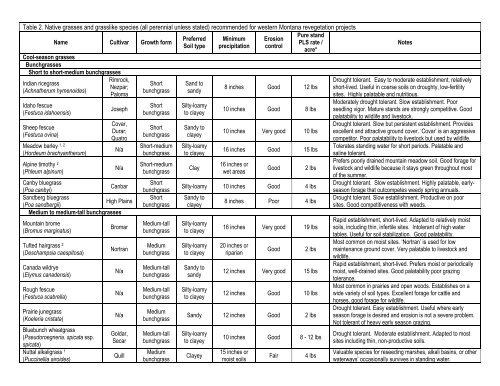Revegetation Guidelines for Western Montana - Global Restoration ...
Revegetation Guidelines for Western Montana - Global Restoration ...
Revegetation Guidelines for Western Montana - Global Restoration ...
Create successful ePaper yourself
Turn your PDF publications into a flip-book with our unique Google optimized e-Paper software.
Table 2. Native grasses and grasslike species (all perennial unless stated) recommended <strong>for</strong> western <strong>Montana</strong> revegetation projects<br />
Name Cultivar Growth <strong>for</strong>m<br />
Pure stand<br />
Preferred Minimum Erosion<br />
PLS rate /<br />
Soil type precipitation control<br />
acre*<br />
Cool-season grasses<br />
Bunchgrasses<br />
Short to short-medium bunchgrasses<br />
Indian ricegrass<br />
(Achnatherum hymenoides)<br />
Idaho fescue<br />
(Festuca idahoensis)<br />
Sheep fescue<br />
(Festuca ovina)<br />
Meadow barley 1, 2<br />
(Hordeum brachyantherum)<br />
Alpine timothy 2<br />
(Phleum alpinum)<br />
Rimrock,<br />
Nezpar;<br />
Paloma<br />
Joseph<br />
Covar,<br />
Durar;<br />
Quatro<br />
N/a<br />
N/a<br />
Canby bluegrass<br />
(Poa canbyi)<br />
Canbar<br />
Sandberg bluegrass<br />
(Poa sandbergii)<br />
High Plains<br />
Medium to medium-tall bunchgrasses<br />
Mountain brome<br />
(Bromus marginatus)<br />
Tufted hairgrass 2<br />
(Deschampsia caespitosa)<br />
Canada wildrye<br />
(Elymus canadensis)<br />
Rough fescue<br />
(Festuca scabrella)<br />
Prairie junegrass<br />
(Koeleria cristata)<br />
Bluebunch wheatgrass<br />
(Pseudoroegneria. spicata ssp.<br />
spicata)<br />
Nuttal alkaligrass 1<br />
(Puccinellia airoides)<br />
Bromar<br />
Nortran<br />
N/a<br />
N/a<br />
N/a<br />
Goldar,<br />
Secar<br />
Quill<br />
Short<br />
bunchgrass<br />
Short<br />
bunchgrass<br />
Short<br />
bunchgrass<br />
Short-medium<br />
bunchgrass<br />
Short-medium<br />
bunchgrass<br />
Short<br />
bunchgrass<br />
Short<br />
bunchgrass<br />
Medium-tall<br />
bunchgrass<br />
Medium<br />
bunchgrass<br />
Medium-tall<br />
bunchgrass<br />
Medium-tall<br />
bunchgrass<br />
Medium<br />
bunchgrass<br />
Medium-tall<br />
bunchgrass<br />
Medium<br />
bunchgrass<br />
Sand to<br />
sandy<br />
Silty-loamy<br />
to clayey<br />
Sandy to<br />
clayey<br />
Silty-loamy<br />
to clayey<br />
Clay<br />
8 inches Good 12 lbs<br />
10 inches Good 8 lbs<br />
10 inches Very good 10 lbs<br />
16 inches Good 15 lbs<br />
16 inches or<br />
wet areas<br />
Good<br />
2 lbs<br />
Silty-loamy 10 inches Good 4 lbs<br />
Sandy to<br />
clayey<br />
Silty-loamy<br />
to clayey<br />
Silty-loamy<br />
to clayey<br />
Sandy to<br />
sandy<br />
Silty-loamy<br />
to clayey<br />
8 inches Poor 4 lbs<br />
16 inches Very good 19 lbs<br />
20 inches or<br />
riparian<br />
Good<br />
2 lbs<br />
12 inches Very good 15 lbs<br />
12 inches Good 10 lbs<br />
Sandy 12 inches Good 2 lbs<br />
Silty-loamy<br />
to clayey<br />
Clayey<br />
10 inches Good 8 - 12 lbs<br />
15 inches or<br />
moist soils<br />
Fair<br />
4 lbs<br />
Notes<br />
Drought tolerant. Easy to moderate establishment, relatively<br />
short-lived. Useful in coarse soils on droughty, low-fertility<br />
sites. Highly palatable and nutritious.<br />
Moderately drought tolerant. Slow establishment. Poor<br />
seedling vigor. Mature stands are strongly competitive. Good<br />
palatability to wildlife and livestock.<br />
Drought tolerant. Slow but persistent establishment. Provides<br />
excellent and attractive ground cover. ‘Covar’ is an aggressive<br />
competitor. Poor palatability to livestock but used by wildlife.<br />
Tolerates standing water <strong>for</strong> short periods. Palatable and<br />
saline tolerant.<br />
Prefers poorly drained mountain meadow soil. Good <strong>for</strong>age <strong>for</strong><br />
livestock and wildlife because it stays green throughout most<br />
of the summer.<br />
Drought tolerant. Slow establishment. Highly palatable, earlyseason<br />
<strong>for</strong>age that outcompetes weedy spring annuals.<br />
Drought tolerant. Slow establishment. Productive on poor<br />
sites. Good competitiveness with weeds.<br />
Rapid establishment, short-lived. Adapted to relatively moist<br />
soils, including thin, infertile sites. Intolerant of high water<br />
tables. Useful <strong>for</strong> soil stabilization. Good palatability.<br />
Most common on moist sites. ‘Nortran’ is used <strong>for</strong> low<br />
maintenance ground cover. Very palatable to livestock and<br />
wildlife.<br />
Rapid establishment, short-lived. Prefers moist or periodically<br />
moist, well-drained sites. Good palatability poor grazing<br />
tolerance.<br />
Most common in prairies and open woods. Establishes on a<br />
wide variety of soil types. Excellent <strong>for</strong>age <strong>for</strong> cattle and<br />
horses, good <strong>for</strong>age <strong>for</strong> wildlife.<br />
Drought tolerant. Easy establishment. Useful where early<br />
season <strong>for</strong>age is desired and erosion is not a severe problem.<br />
Not tolerant of heavy early season grazing.<br />
Drought tolerant. Moderate establishment. Adapted to most<br />
sites including thin, non-productive soils.<br />
Valuable species <strong>for</strong> reseeding marshes, alkali basins, or other<br />
waterways’ occasionally survives in standing water.

















